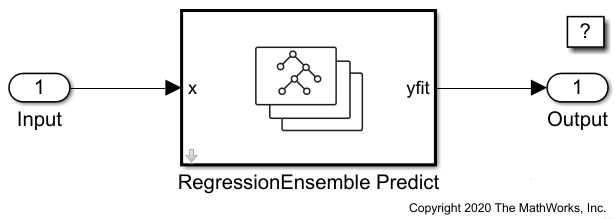RegressionEnsemble Predict
Libraries:
Statistics and Machine Learning Toolbox /
Regression
Description
The RegressionEnsemble Predict block predicts responses using an ensemble
of decision trees (RegressionEnsemble, RegressionBaggedEnsemble, or CompactRegressionEnsemble).
Import a trained regression object into the block by specifying the name of a workspace variable that contains the object. The input port x receives an observation (predictor data), and the output port yfit returns a predicted response for the observation.
Examples
Ports
Input
Output
Parameters
Block Characteristics
Data Types |
|
Direct Feedthrough |
|
Multidimensional Signals |
|
Variable-Size Signals |
|
Zero-Crossing Detection |
|
More About
Alternative Functionality
You can use a MATLAB Function block with the predict object function of an ensemble of decision trees (RegressionEnsemble, RegressionBaggedEnsemble, or CompactRegressionEnsemble). For an example, see Predict Class Labels Using MATLAB Function Block.
When deciding whether to use the RegressionEnsemble Predict block in the
Statistics and Machine Learning Toolbox™ library or a MATLAB Function block with the predict function, consider the
following:
If you use the Statistics and Machine Learning Toolbox library block, you can use the Fixed-Point Tool (Fixed-Point Designer) to convert a floating-point model to fixed point.
Support for variable-size arrays must be enabled for a MATLAB Function block with the
predictfunction.If you use a MATLAB Function block, you can use MATLAB functions for preprocessing or post-processing before or after predictions in the same MATLAB Function block.
Extended Capabilities
Version History
Introduced in R2021a
See Also
Blocks
- RegressionSVM Predict | RegressionTree Predict | RegressionNeuralNetwork Predict | RegressionGP Predict | ClassificationEnsemble Predict

